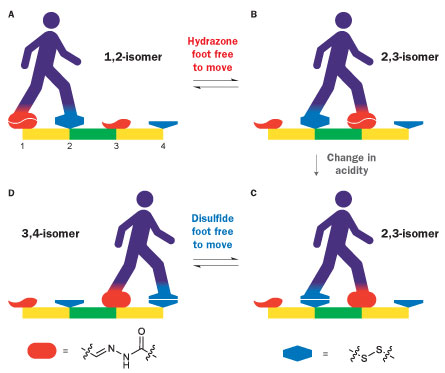- More than 2 years ago
In one very small step for mankind, researchers have designed a tiny molecule that can walk on a track. Such artificial walkers may one day carry cargo purposefully, much like natural proteins in the body.

The new walking system, reported in the February Nature Chemistry, is “a pretty big leap forward,” comments chemist Charles Sykes of Tufts University in Medford, Mass.
In the body, motor proteins walk in one direction along molecular tracks inside cells, hauling their load as they go. These biomotors transport big loads, such as organelles, lipids and vesicles, to the desired destinations in the cell.
“Nature is full of tiny molecular motors,” Sykes says. “Mankind hasn’t been able to build anything comparable,” in part, because it’s very hard to scale down to the microscopic level, where ordinary forces such as gravity are negligible, he says.
In the new study, researchers led by David Leigh of the University of Edinburgh designed a two-legged walker made up of 21 atoms and a track made up of “stepping stone” molecules designed to react chemically with the walker’s two “feet.” There are two types of stepping stones for each of the walking molecule’s two feet. Those feet are chemically different — one consists of a chemical latch called a hydrazide and the other is a latch called a thiol. This design allows each foot to grab on to every other stepping stone.
A wash of an acidic solution loosens one foot from its hold on the track and allows it to bind to the next open step. A wash of a basic solution loosens the other foot. As the chemical environment changes, the walker’s legs scissor as they move, a motion the researchers called the “passing leg gait.” This design, in which the walker always has one foot firmly bound to the track, helps to keep the walker on the track.
On average, the walkers took 37 steps back and forth on the four-step track before falling off, which corresponds to a traveled distance of 26 nanometers, the researchers found. In contrast, an important motor protein in the body, kinesin, takes between 75 and 175 steps along its track without falling off, the researchers note.
In the new system, some walkers reached the end of the track, but not all did. In the original design, each loose foot could bind to a step ahead or to the step it just left, yielding no net directional movement. To counter that problem, the researchers then replaced the basic step with an irreversible reaction. This reaction, called a redox reaction, made the walker much more likely to take a step forward than backward.
Using these chemicals to build an artificial walker is “a very clever approach,” comments chemist James Tour of Rice University in Houston. “It’s just the beginning, though.” This system is still a long way from being able to carry cargo in artificial systems.
Man-made walkers might be used someday in micromachines to walk up and down walls carrying fans to channel fluid in a desired direction. Or, tiny walkers could bind to viruses and carry them off. Such ideas are many years off, but the new study suggests that they may one day work, Tour says.






